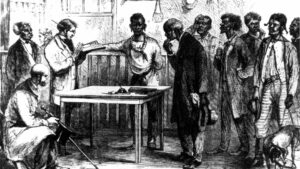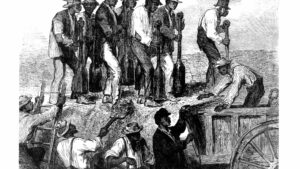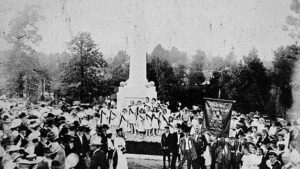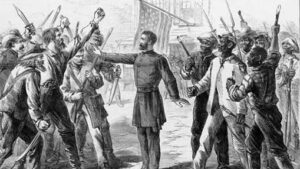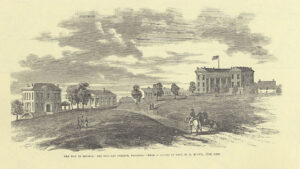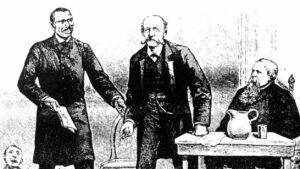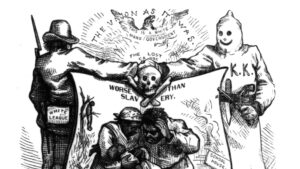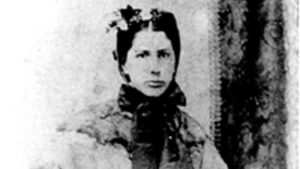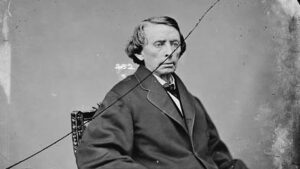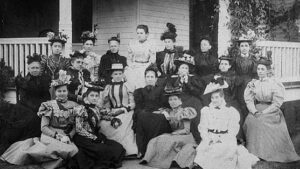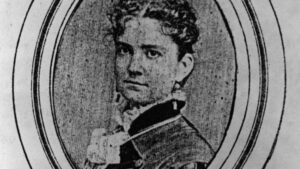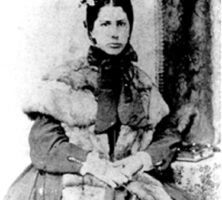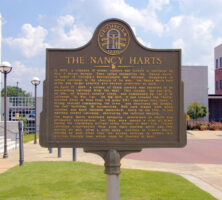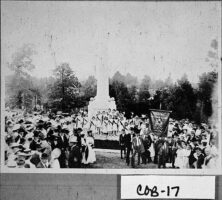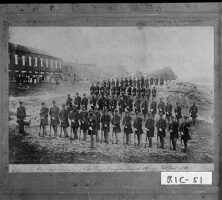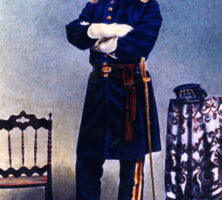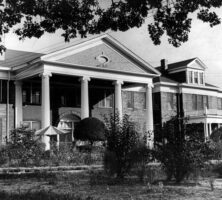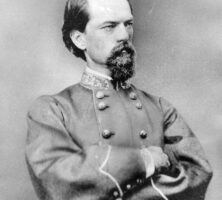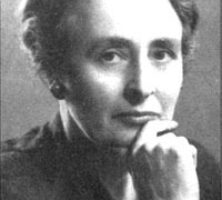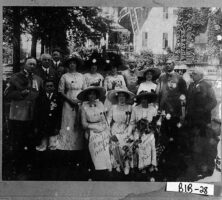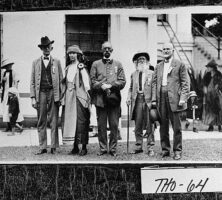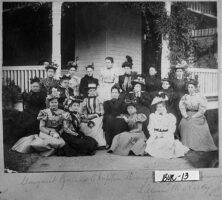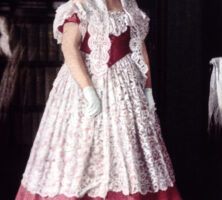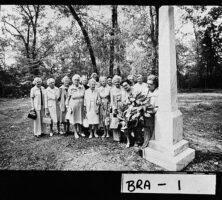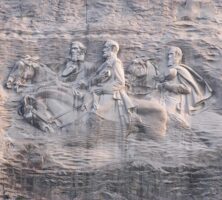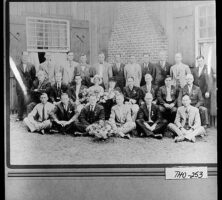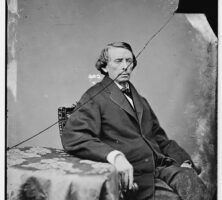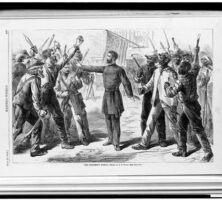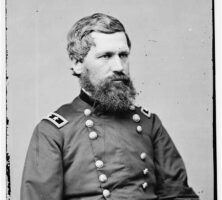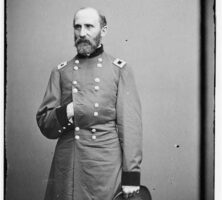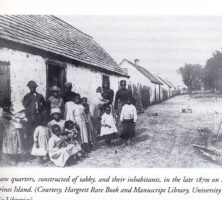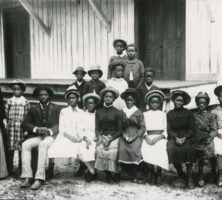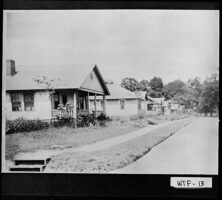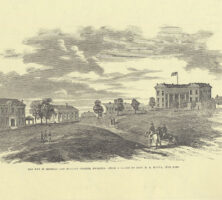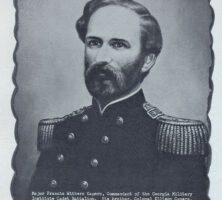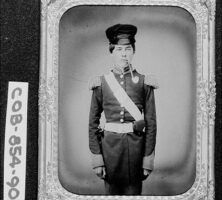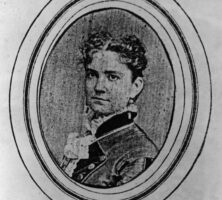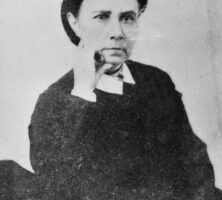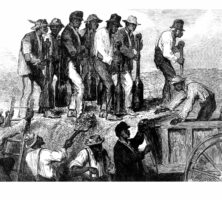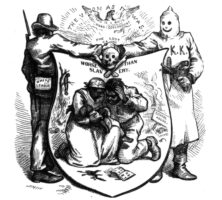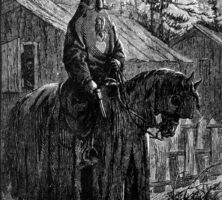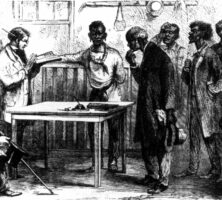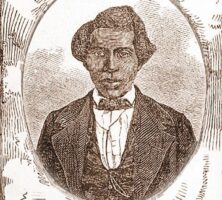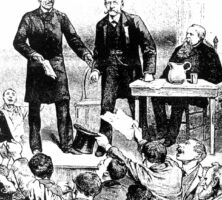The New Georgia Encyclopedia is supported by funding from A More Perfect Union, a special initiative of the National Endowment for the Humanities.
During the Civil War, Nancy Hill Morgan cofounded the Nancy Harts Militia, a female military unit organized in LaGrange to protect the home front. Morgan, the wife of a Confederate soldier, served as captain of the militia.
Courtesy of Troup County Archives
The New Georgia Encyclopedia does not hold the copyright for this media resource and can neither grant nor deny permission to republish or reproduce the image online or in print. All requests for permission to publish or reproduce the resource must be submitted to the rights holder.
In 1957 the Georgia Historical Commission erected a marker in LaGrange commemorating the Nancy Harts Militia, a female military unit named for Revolutionary War heroine Nancy Hart and organized to guard the city during the Civil War.
Courtesy of Georgia Info, Digital Library of Georgia.
The New Georgia Encyclopedia does not hold the copyright for this media resource and can neither grant nor deny permission to republish or reproduce the image online or in print. Requests for permission to publish or reproduce the resource may need to be submitted to the Digital Library of Georgia.
A conference of the United Confederate Veterans is pictured in Marietta, circa 1900. The UCV was founded in New Orleans, Louisiana, in 1889 to unify the numerous Confederate veteran organizations across the South.
Courtesy of Georgia Archives, Vanishing Georgia, #
cob017.
The New Georgia Encyclopedia does not hold the copyright for this media resource and can neither grant nor deny permission to republish or reproduce the image online or in print. Requests for permission to publish or reproduce the resource should be submitted to the Georgia Archives.
Company D of the 1st Regiment Georgia Volunteer Infantry, known as the Oglethorpe Infantry, are pictured in Augusta in April 1861, at the beginning of the Civil War. This unit was among the first to form a veterans' organization, the Oglethorpe Light Infantry Association in Savannah, at the war's end in 1865.
Courtesy of Georgia Archives, Vanishing Georgia, #
ric051.
The New Georgia Encyclopedia does not hold the copyright for this media resource and can neither grant nor deny permission to republish or reproduce the image online or in print. Requests for permission to publish or reproduce the resource should be submitted to the Georgia Archives.
Charles C. Jones Jr. was the foremost Georgia historian of the nineteenth century. Beginning after the Civil War and continuing into the 1880s, Jones collected Confederate service records and reminiscences of former soliders.
The New Georgia Encyclopedia does not hold the copyright for this media resource and can neither grant nor deny permission to republish or reproduce the image online or in print. Requests for permission to publish or reproduce the resource should be submitted to the Hargrett Manuscript and Rare Book Library at the University of Georgia.
Confederate Soldiers' Home, located at 410 Confederate Avenue in Atlanta, was built in 1902 to house aging Confederate veterans of the Civil War. The Inman family provided a portion of the funds necessary for the home's completion.
Courtesy of Atlanta Journal-Constitution.
The New Georgia Encyclopedia does not hold the copyright for this media resource and can neither grant nor deny permission to republish or reproduce the image online or in print. All requests for permission to publish or reproduce the resource must be submitted to the Atlanta Journal-Constitution.
John B. Gordon rose to prominence during the Civil War, entering as a captain and emerging as a major general. He later served as a U.S. senator and as the governor of Georgia.
Photograph by Wikimedia
The New Georgia Encyclopedia does not hold the copyright for this media resource and can neither grant nor deny permission to republish or reproduce the image online or in print. All requests for permission to publish or reproduce the resource must be submitted to the rights holder.
Lumpkin is best known for her autobiographical novel, The Making of a Southerner (1947), which describes her transition from passive inheritance of white supremacy to conscious rejection of the racial values of a segregated South.
From The Making of a Southerner, by K. D. Lumpkin
The New Georgia Encyclopedia does not hold the copyright for this media resource and can neither grant nor deny permission to republish or reproduce the image online or in print. All requests for permission to publish or reproduce the resource must be submitted to the rights holder.
Attendees of the 1912 national United Confederate Veterans reunion are pictured in Macon, which hosted the event that year. Macon was the only Georgia city besides Atlanta to host the general reunion of the UCV.
Courtesy of Georgia Archives, Vanishing Georgia, #
bib028.
The New Georgia Encyclopedia does not hold the copyright for this media resource and can neither grant nor deny permission to republish or reproduce the image online or in print. Requests for permission to publish or reproduce the resource should be submitted to the Georgia Archives.
Four Confederate veterans attend a reunion in Thomasville in October 1924.
Courtesy of Georgia Archives, Vanishing Georgia, #
tho064.
The New Georgia Encyclopedia does not hold the copyright for this media resource and can neither grant nor deny permission to republish or reproduce the image online or in print. Requests for permission to publish or reproduce the resource should be submitted to the Georgia Archives.
Members of the Margaret Jones Chapter of the United Daughters of the Confederacy are pictured in Waynesboro, circa 1900. Lillian W. Neely (center of top row in white dress) was president of the chapter at this time. The Georgia Division of the UDC was formed in 1895.
Courtesy of Georgia Archives, Vanishing Georgia, #
bur013.
The New Georgia Encyclopedia does not hold the copyright for this media resource and can neither grant nor deny permission to republish or reproduce the image online or in print. Requests for permission to publish or reproduce the resource should be submitted to the Georgia Archives.
Mildred Lewis Rutherford taught at the Lucy Cobb Institute in Athens from 1880 to 1928, serving as principal of the school for twenty-two of those years. A prominent member of the United Daughters of the Confederacy and an advocate for the "Lost Cause" interpretation of the Civil War, Rutherford also published a number of books on southern history.
The New Georgia Encyclopedia does not hold the copyright for this media resource and can neither grant nor deny permission to republish or reproduce the image online or in print. Requests for permission to publish or reproduce the resource should be submitted to the Hargrett Manuscript and Rare Book Library at the University of Georgia.
Members of the Lanier of Glynn Chapter of the United Daughters of the Confederacy, pictured in 1979, decorate a monument in Brantley County dedicated to Confederate soldiers who died of yellow fever during the Civil War.
Courtesy of Georgia Archives, Vanishing Georgia, #
bra001.
The New Georgia Encyclopedia does not hold the copyright for this media resource and can neither grant nor deny permission to republish or reproduce the image online or in print. Requests for permission to publish or reproduce the resource should be submitted to the Georgia Archives.
The carving on Stone Mountain depicts the Confederate icons Robert E. Lee, Thomas "Stonewall" Jackson, and Jefferson Davis. Commissioned by the president of the United Daughters of the Confederacy, the sculptor Gutzon Borglum began work on the relief in 1915. He was fired in 1925, and Augustus Lukeman completed the carving.
Photograph by Mark Griffin, Wikimedia
The New Georgia Encyclopedia does not hold the copyright for this media resource and can neither grant nor deny permission to republish or reproduce the image online or in print. All requests for permission to publish or reproduce the resource must be submitted to the rights holder.
Descendants of Confederate veterans who served in World War I received the Cross of Honor from the United Daughters of the Confederacy in Thomasville, circa 1920.
Courtesy of Georgia Archives, Vanishing Georgia, #
tho253.
The New Georgia Encyclopedia does not hold the copyright for this media resource and can neither grant nor deny permission to republish or reproduce the image online or in print. Requests for permission to publish or reproduce the resource should be submitted to the Georgia Archives.
The New Georgia Encyclopedia does not hold the copyright for this media resource and can neither grant nor deny permission to republish or reproduce the image online or in print. All requests for permission to publish or reproduce the resource must be submitted to the rights holder.
William G. "Parson" Brownlow, a future Tennessee governor and U.S. senator, was a prominent Southern Unionist during the Civil War. He defined a true Unionist as one who held both an "uncompromising devotion" to the Union and "unmitigated hostility" to the Confederacy, as well as a willingness to risk life and property "in defense of the Glorious Stars and Stripes."
Courtesy of Library of Congress, Prints and Photographs Division
The New Georgia Encyclopedia does not hold the copyright for this media resource and can neither grant nor deny permission to republish or reproduce the image online or in print. All requests for permission to publish or reproduce the resource must be submitted to the rights holder.
An 1868 sketch by A. R. Waud illustrates the difficulties faced by the Freedmen's Bureau, caught between white planters on one side (left) and formerly enslaved African Americans on the other (right). The bureau was established in 1865 after Union general William T. Sherman issued his Field Order No. 15, which called for the resettlement of freedpeople on confiscated lands.
Courtesy of Library of Congress, Prints and Photographs Division
The New Georgia Encyclopedia does not hold the copyright for this media resource and can neither grant nor deny permission to republish or reproduce the image online or in print. All requests for permission to publish or reproduce the resource must be submitted to the rights holder.
Major General Oliver O. Howard served as director of the Freedmen's Bureau, an agency that provided social welfare to formerly enslaved African Americans from 1865 until 1872. Operations of the bureau ceased in Georgia in 1870.
Courtesy of Library of Congress, Prints and Photographs Division
The New Georgia Encyclopedia does not hold the copyright for this media resource and can neither grant nor deny permission to republish or reproduce the image online or in print. All requests for permission to publish or reproduce the resource must be submitted to the rights holder.
Brigadier General Rufus Saxton served as the first assistant commissioner of the Freedmen's Bureau assigned to Georgia, South Carolina, and Florida. During his four-month tenure in 1865, Saxton advocated free labor and land acquisitions for freedpeople.
Courtesy of Library of Congress, Prints and Photographs Division
The New Georgia Encyclopedia does not hold the copyright for this media resource and can neither grant nor deny permission to republish or reproduce the image online or in print. All requests for permission to publish or reproduce the resource must be submitted to the rights holder.
The New Georgia Encyclopedia does not hold the copyright for this media resource and can neither grant nor deny permission to republish or reproduce the image online or in print. All requests for permission to publish or reproduce the resource must be submitted to the rights holder.
A family, pictured in the 1880s, stands outside old slave quarters on St. Catherines Island. The island served as the headquarters for Tunis Campbell, an agent of the Freedmen's Bureau who was assigned to supervise land claims and resettlement on five Georgia islands after the Civil War.
Courtesy of Hargrett Rare Book and Manuscript Library, University of Georgia Libraries, Georgia Photo File.
The New Georgia Encyclopedia does not hold the copyright for this media resource and can neither grant nor deny permission to republish or reproduce the image online or in print. Requests for permission to publish or reproduce the resource should be submitted to the Hargrett Manuscript and Rare Book Library at the University of Georgia.
African American schoolchildren are pictured in Liberty County, circa 1890. The Freedmen's Bureau established numerous schools in Georgia from 1865 to 1870, and local education societies continued to administer the schools after the bureau's closure.
The New Georgia Encyclopedia does not hold the copyright for this media resource and can neither grant nor deny permission to republish or reproduce the image online or in print. Requests for permission to publish or reproduce the resource should be submitted to the Hargrett Manuscript and Rare Book Library at the University of Georgia.
Mill houses line a street in Dalton, circa 1930. The carpet and textile industries in the city began in the late nineteenth century with the tufted bedspreads of Catherine Evans Whitener and by the 1940s had developed into a mechanized industry in Whitfield County.
Courtesy of Georgia Archives, Vanishing Georgia, #
wtf013a.
The New Georgia Encyclopedia does not hold the copyright for this media resource and can neither grant nor deny permission to republish or reproduce the image online or in print. Requests for permission to publish or reproduce the resource should be submitted to the Georgia Archives.
The Georgia Military Institute was founded in Marietta in 1851 to educate new engineers and teachers for the state. Many GMI students were called to active duty during the Civil War, and the school was burned by Union troops in 1864. It never reopened. Sketch by Captain D. R. Brown of the 20th Connecticut.
From History of the Georgia Military Institute, by Bowling C. Yates
The New Georgia Encyclopedia does not hold the copyright for this media resource and can neither grant nor deny permission to republish or reproduce the image online or in print. All requests for permission to publish or reproduce the resource must be submitted to the rights holder.
Francis W. Capers, the superintendent of the Georgia Military Institute in Marietta at the start of the Civil War, provided drill instructors from among the school's cadets to train new Confederate soldiers. In May 1864 he led his cadets as a volunteer unit in the Confederate army and attempted to halt the advance of Union troops into Georgia.
From History of the Georgia Military Institute, by Bowling C. Yates
The New Georgia Encyclopedia does not hold the copyright for this media resource and can neither grant nor deny permission to republish or reproduce the image online or in print. All requests for permission to publish or reproduce the resource must be submitted to the rights holder.
Jonathan L. D. Lamar, a cadet at the Georgia Military Institute in Marietta, poses in his uniform for a tintype made around 1856. During this time the school enrolled between 150 and 200 cadets, many of whom came from Georgia's wealthiest families.
Courtesy of Georgia Archives, Vanishing Georgia, #
cob854-90.
The New Georgia Encyclopedia does not hold the copyright for this media resource and can neither grant nor deny permission to republish or reproduce the image online or in print. Requests for permission to publish or reproduce the resource should be submitted to the Georgia Archives.
Sallie Clayton, an adolescent at the time of the Civil War, recounted memories of her own and her family's ordeal in Requiem for a Lost City.
Courtesy of Atlanta Historical Society
The New Georgia Encyclopedia does not hold the copyright for this media resource and can neither grant nor deny permission to republish or reproduce the image online or in print. All requests for permission to publish or reproduce the resource must be submitted to the rights holder.
The New Georgia Encyclopedia does not hold the copyright for this media resource and can neither grant nor deny permission to republish or reproduce the image online or in print. All requests for permission to publish or reproduce the resource must be submitted to the rights holder.
Mary Harris Gay, a Decatur native, wrote Life in Dixie during the War (1892), in which she recounted her memories of watching the Civil War battle of Decatur.
Courtesy of Georgia Archives, Vanishing Georgia, #dek418-85.
The New Georgia Encyclopedia does not hold the copyright for this media resource and can neither grant nor deny permission to republish or reproduce the image online or in print. Requests for permission to publish or reproduce the resource should be submitted to the Georgia Archives.
The New Georgia Encyclopedia does not hold the copyright for this media resource and can neither grant nor deny permission to republish or reproduce the image online or in print. All requests for permission to publish or reproduce the resource must be submitted to the rights holder.
The New Georgia Encyclopedia does not hold the copyright for this media resource and can neither grant nor deny permission to republish or reproduce the image online or in print. All requests for permission to publish or reproduce the resource must be submitted to the rights holder.
The New Georgia Encyclopedia does not hold the copyright for this media resource and can neither grant nor deny permission to republish or reproduce the image online or in print. All requests for permission to publish or reproduce the resource must be submitted to the rights holder.
The enrollment of Black soldiers began in occupied areas of northwestern Georgia between July and September 1864, when the 44th U.S. Colored Infantry was stationed in Rome, Georgia, for recruiting purposes.
Courtesy of London Illustrated News
The New Georgia Encyclopedia does not hold the copyright for this media resource and can neither grant nor deny permission to republish or reproduce the image online or in print. All requests for permission to publish or reproduce the resource must be submitted to the rights holder.
The New Georgia Encyclopedia does not hold the copyright for this media resource and can neither grant nor deny permission to republish or reproduce the image online or in print. All requests for permission to publish or reproduce the resource must be submitted to the rights holder.
The New Georgia Encyclopedia does not hold the copyright for this media resource and can neither grant nor deny permission to republish or reproduce the image online or in print. All requests for permission to publish or reproduce the resource must be submitted to the rights holder.
Most Ku Klux Klan action was designed to intimidate Black voters and white supporters of the Republican Party. Founded in Tennessee in 1866, the Klan was particularly active in Georgia from 1868 to the early 1870s.
From Harper's Weekly
The New Georgia Encyclopedia does not hold the copyright for this media resource and can neither grant nor deny permission to republish or reproduce the image online or in print. All requests for permission to publish or reproduce the resource must be submitted to the rights holder.
The Ku Klux Klan was a loosely organized group of political and social terrorists during the Reconstruction, whose goals included political defeat of the Republican Party and the maintenance of absolute white supremacy in response to newly gained civil and political rights by southern Blacks after the Civil War.
From The Invisible Empire, by A. W. Tourgee
The New Georgia Encyclopedia does not hold the copyright for this media resource and can neither grant nor deny permission to republish or reproduce the image online or in print. All requests for permission to publish or reproduce the resource must be submitted to the rights holder.
Freedmen, pictured in September 1867, registered to vote during Congressional Reconstruction in drives conducted by the U.S. military. Between 1867 and 1872, sixty-nine African Americans from Georgia served either as delegates to the 1867 constitutional convention or as members of the state legislature.
From Harper's Weekly
The New Georgia Encyclopedia does not hold the copyright for this media resource and can neither grant nor deny permission to republish or reproduce the image online or in print. All requests for permission to publish or reproduce the resource must be submitted to the rights holder.
This sketch (circa 1848) of Tunis Campbell is the only known image of the prominent Black politician and minister. After serving as a Union chaplain during the Civil War, Campbell became a prominent leader of the Republican party in Georgia during Reconstruction.
Courtesy of Moorland-Spingarn Research Center, Howard University
The New Georgia Encyclopedia does not hold the copyright for this media resource and can neither grant nor deny permission to republish or reproduce the image online or in print. All requests for permission to publish or reproduce the resource must be submitted to the rights holder.
The Knights of Labor played a pioneering role in organizing American and especially southern laborers. In Georgia the Knights gave workers an outlet for protest against low wages and harsh working conditions in relatively new industries, as well as the means to challenge Democratic dominance of local politics.
From Harper's Weekly
The New Georgia Encyclopedia does not hold the copyright for this media resource and can neither grant nor deny permission to republish or reproduce the image online or in print. All requests for permission to publish or reproduce the resource must be submitted to the rights holder.
